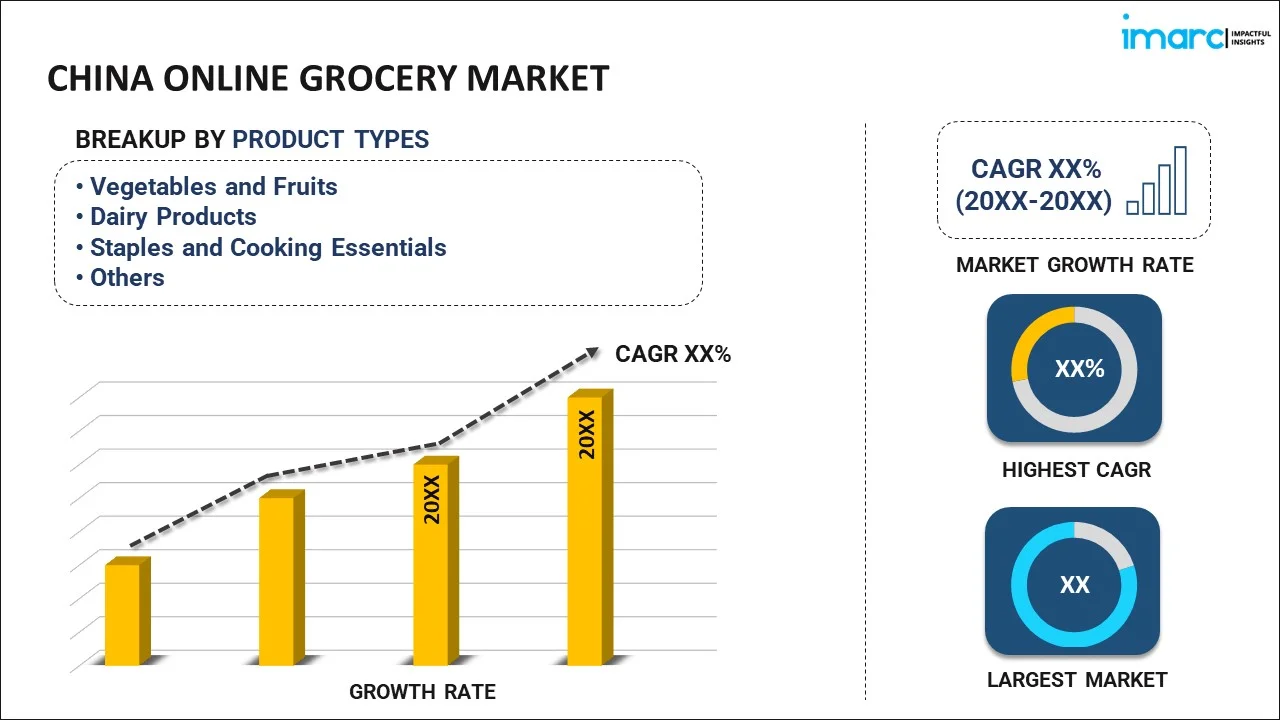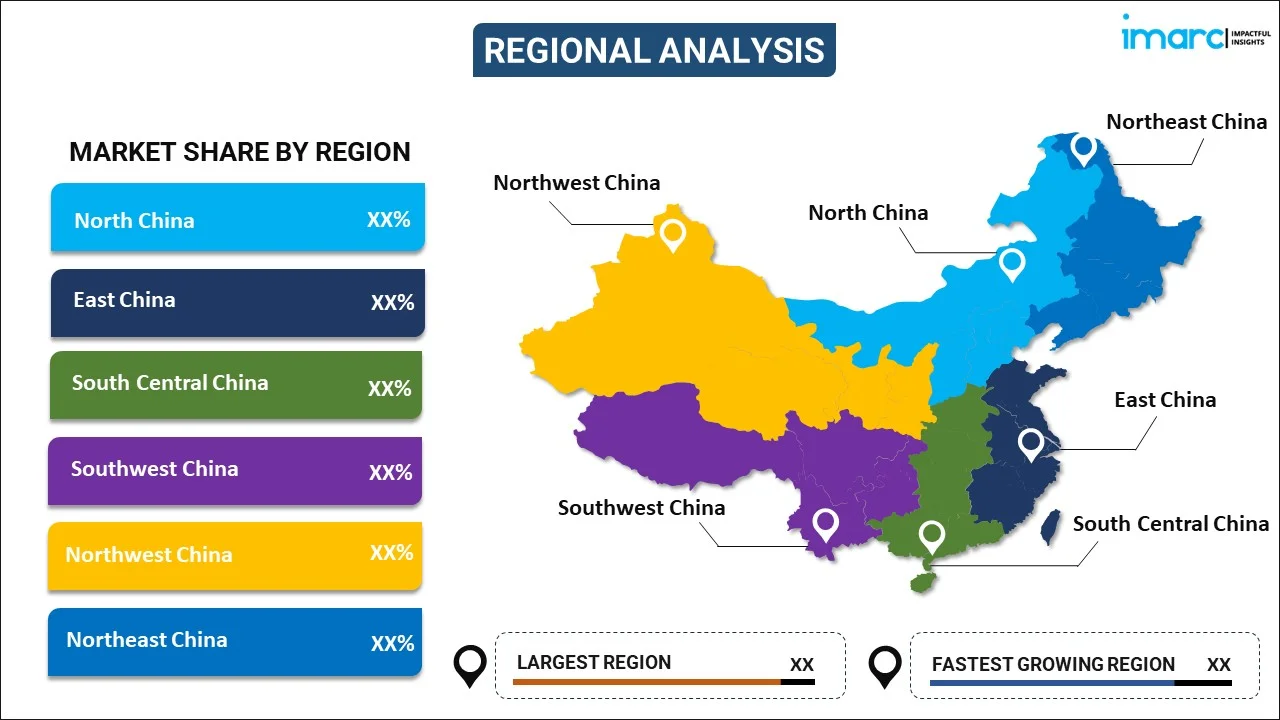
China Online Grocery Market Report by Product Type (Vegetables and Fruits, Dairy Products, Staples and Cooking Essentials, Snacks, Meat and Seafood, and Others), Business Model (Pure Marketplace, Hybrid Marketplace, and Others), Platform (Web-Based, App-Based), Purchase Type (One-Time, Subscription), and Region 2025-2033
China Online Grocery Market Overview:
China online grocery market size reached USD 117.1 Billion in 2024. Looking forward, IMARC Group expects the market to reach USD 918.9 Billion by 2033, exhibiting a growth rate (CAGR) of 25.73% during 2025-2033. The widespread adoption of digital technologies, the increasing internet penetration, and the rising demand for convenience in shopping represent some of the key factors driving the market growth across the country. In 2019, China led the global e-commerce market with sales around USD 2 Trillion.
|
Report Attribute
|
Key Statistics
|
|---|---|
|
Base Year
|
2024
|
|
Forecast Years
|
2025-2033
|
|
Historical Years
|
2019-2024
|
|
Market Size in 2024
|
USD 117.1 Billion |
|
Market Forecast in 2033
|
USD 918.9 Billion |
| Market Growth Rate 2025-2033 | 25.73% |
Online grocery shopping is a modern and convenient method of purchasing food and household essentials through digital platforms, without the need to visit physical stores. This e-commerce trend has transformed the traditional grocery shopping experience by leveraging the power of the internet and digital grocery technology. Customers can browse a wide array of products, including fresh produce, pantry staples, dairy, meat, and household items, on dedicated online grocery platforms or the websites of established grocery chains. The process typically involves users selecting items through a user-friendly interface, adding them to a virtual cart, and proceeding to an online checkout. Transactions are completed electronically, and customers can choose from various payment options, including credit/debit cards or digital wallets. Once the order is confirmed, the online grocery service arranges for the delivery of the selected items to the customer's doorstep at a scheduled time. Online grocery shopping offers numerous advantages to consumers. It provides a time-saving solution, eliminating the need for travel and physical shopping.
China Online Grocery Market Trends:
Surge in Deliver in an Hour Services
Chinese online food store customers increasingly expect groceries at their doorstep within the hour. Platforms like Meituan and Dingdong Maicai are retooling operations with micro-fulfillment centers and dense rider networks to enable ultra-fast dispatch. This push is especially strong in urban areas where convenience shapes shopping behavior. The model depends on location-based algorithms and demand forecasting to reduce wait times. For companies, it’s more than just a delivery speed; it builds customer loyalty. Retailers now view fast delivery as a core advantage in a crowded space. As expectations shift from same-day to same-hour, investments in infrastructure, inventory syncing, and local warehousing are transforming how the market defines fast service.
Expansion of Instant Grocery Delivery Models
The online grocery space in China is shifting toward real-time convenience. Shoppers now prefer placing smaller, more frequent orders to meet immediate needs like fresh produce or daily staples. In response, platforms are adding local warehouses and smart inventory tools to serve tight delivery zones. Freshippo and others are promising deliveries in under 30 minutes within specific neighborhoods. The result is a new logistics model that favors hyper-local hubs over large central warehouses. Companies are also teaming up with convenience stores and freelance couriers to expand coverage without building everything from scratch. Quick, reliable service has become a defining feature of grocery apps across urban China. These shifts reflect larger changes underway in the grocery market China is developing to meet modern consumption habits.
Push for Eco-Friendly Delivery and Packaging
Environmental concerns are influencing how groceries are delivered in China. Companies are beginning to use electric scooters, biodegradable bags, and reusable containers for order fulfillment. With order volumes growing, the industry is under pressure to reduce plastic use and emissions. Some platforms now reward customers who choose green delivery slots or consolidate purchases into fewer shipments. There are also return programs where packaging can be sent back during the next delivery. These shifts are being driven by both consumer expectations and new regulatory measures. What was once a niche focus is now shaping delivery methods and operational planning across many Chinese super market online platforms.
Tech-Driven Shifts in Consumer Grocery Habits
Digital tools are changing how Chinese consumers shop for groceries. Live-streaming sessions now double as product showcases, while voice assistants help with reorders and reminders. Grocery apps are adding social features, reward games, and personalized coupons to encourage repeat use. AI-based product suggestions and flash sales increase customer engagement and drive extra purchases. With mobile apps at the center of this shift, speed and user experience are as important as price. Digital wallets like Alipay and WeChat Pay make checkout nearly instant. As consumers adopt these tools into their daily routines, Chinese online grocery store apps become integrated into daily life rather than treated as a separate channel.
AI Reshaping Online Grocery Operations
Artificial intelligence is now at the heart of how online grocery platforms function in China. It helps forecast demand, optimize delivery routes, and manage customer service. Platforms use AI to tailor product recommendations, run chatbots, and adjust pricing in real time. Warehouse operations increasingly rely on robots to pick, sort, and pack items for rapid dispatch. These systems reduce human error, improve efficiency, and lower costs. More importantly, AI allows companies to personalize shopping experiences for millions of users. What feels like a one-to-one service is often powered by back-end systems that analyze behavior, preferences, and buying patterns at a massive scale. Major players across the China online supermarket sector are now investing heavily in these tools to gain an edge. As the China online grocery market size 2024 is projected to reach new highs, AI has become central to how companies scale operations to meet growing demand. Rising order volumes, especially in second- and third-tier cities, are pushing platforms to automate decision-making across fulfillment, marketing, and customer support. The competitive landscape is being shaped by how effectively retailers can deploy smart systems to improve accuracy and speed without inflating costs.
China Online Grocery Market Segmentation:
IMARC Group provides an analysis of the key trends in each segment of the market, along with forecasts at the country level for 2025-2033. Our report has categorized the market based on product type, business model, platform, and purchase type.
Product Type Insights:

To get more information on this market, Request Sample
- Vegetables and Fruits
- Dairy Products
- Staples and Cooking Essentials
- Snacks
- Meat and Seafood
- Others
The report has provided a detailed breakup and analysis of the market based on the product type. This includes vegetables and fruits, dairy products, staples and cooking essentials, snacks, meat and seafood, and others.
Business Model Insights:
- Pure Marketplace
- Hybrid Marketplace
- Others
A detailed breakup and analysis of the market based on the business model have also been provided in the report. This includes pure marketplace, hybrid marketplace, and others.
Platform Insights:
- Web-Based
- App-Based
The report has provided a detailed breakup and analysis of the market based on the platform. This includes web-based and app-based.
Purchase Type Insights:
- One-Time
- Subscription
A detailed breakup and analysis of the market based on the purchase type have also been provided in the report. This includes one-time and subscription.
Regional Insights:

- North China
- East China
- South Central China
- Southwest China
- Northwest China
- Northeast China
The report has also provided a comprehensive analysis of all the major regional markets, which include North China, East China, South Central China, Southwest China, Northwest China, and Northeast China.
Competitive Landscape:
The market research report has also provided a comprehensive analysis of the competitive landscape in the market. Competitive analysis such as market structure, key player positioning, top winning strategies, competitive dashboard, and company evaluation quadrant has been covered in the report. Also, detailed profiles of all major companies have been provided.
China Online Grocery Market News:
- In June 2025, Keeta, the global arm of China’s top food delivery app, expanded to the Gulf, with Kuwait set as a launchpad. The company will introduce rapid food and grocery delivery services, marking its first major move outside China. Recruitment is nearly complete, and operations are expected to begin in late 2025 or early 2026. This reflects a strategic shift in China's online grocery market toward international growth.
- In July 2024, Meituan reported a 21% jump in Q2 revenue, reaching CNY 82.3 Billion, surpassing analyst expectations despite China’s slow economic recovery. The company’s growth is driven by rising demand for low-cost, discounted products and efficient delivery. Its broad service range, including grocery and essentials, continues to gain traction as consumers increasingly prioritize value and convenience, solidifying Meituan’s position in China’s expanding online grocery and retail delivery market.
China Online Grocery Market Report Coverage:
| Report Features | Details |
|---|---|
| Base Year of the Analysis | 2024 |
| Historical Period | 2019-2024 |
| Forecast Period | 2025-2033 |
| Units | Billion USD |
| Scope of the Report | Exploration of Historical Trends and Market Outlook, Industry Catalysts and Challenges, Segment-Wise Historical and Future Market Assessment:
|
| Product Types Covered | Vegetables and Fruits, Dairy Products, Staples and Cooking Essentials, Snacks, Meat and Seafood, Others |
| Business Models Covered | Pure Marketplace, Hybrid Marketplace, Others |
| Platforms Covered | Web-Based, App-Based |
| Purchase Types Covered | One-Time, Subscription |
| Regions Covered | North China, East China, South Central China, Southwest China, Northwest China, Northeast China |
| Customization Scope | 10% Free Customization |
| Post-Sale Analyst Support | 10-12 Weeks |
| Delivery Format | PDF and Excel through Email (We can also provide the editable version of the report in PPT/Word format on special request) |
Key Benefits for Stakeholders:
- IMARC’s industry report offers a comprehensive quantitative analysis of various market segments, historical and current market trends, market forecasts, and dynamics of the China online grocery market from 2019-2033.
- The research report provides the latest information on the market drivers, challenges, and opportunities in the China online grocery market.
- Porter's five forces analysis assist stakeholders in assessing the impact of new entrants, competitive rivalry, supplier power, buyer power, and the threat of substitution. It helps stakeholders to analyze the level of competition within the China online grocery industry and its attractiveness.
- Competitive landscape allows stakeholders to understand their competitive environment and provides an insight into the current positions of key players in the market.
Key Questions Answered in This Report
The online grocery market in China reached USD 117.1 Billion in 2024.
The China online grocery market is projected to exhibit a CAGR of 25.73% during 2025-2033, reaching USD 918.9 Billion by 2033.
Rapid smartphone and digital payment adoption, fast delivery networks, post-COVID online habits, rising incomes and urbanization, government support for rural e-commerce infrastructure, strong investment by e-commerce giants, and growing demand for food safety, fresh produce, promotions, and omnichannel services.
Need more help?
- Speak to our experienced analysts for insights on the current market scenarios.
- Include additional segments and countries to customize the report as per your requirement.
- Gain an unparalleled competitive advantage in your domain by understanding how to utilize the report and positively impacting your operations and revenue.
- For further assistance, please connect with our analysts.
 Request Customization
Request Customization
 Speak to an Analyst
Speak to an Analyst
 Request Brochure
Request Brochure
 Inquire Before Buying
Inquire Before Buying




.webp)




.webp)












